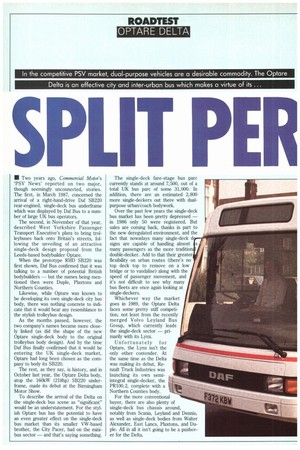• Two years ago, Commercial Motor's 'PSV News' reported on
Page 68

If you've noticed an error in this article please click here to report it so we can fix it.
two major, though seemingly unconnected, stories. The first, in March 1987, concerned the arrival of a right-band-drive Daf SB220 rear-engined, single-deck bus underframe which was displayed by Daf Bus to a number of large UK bus operators.
The second, in November of that year, described West Yorkshire Passenger Transport Executive's plans to bring trolleybuses back onto Britain's streets, following the unveiling of an attractive single-deck design proposal from the Leeds-based bodybuilder Optare.
When the prototype RHD SB220 was first shown, Dal Bus confirmed that it was talking to a number of potential British bodybuilders — but the names being mentioned then were Duple, Plaxtons and Northern Counties.
Likewise, while Optare was known to be developing its own single-deck city bus body, there was nothing concrete to indicate that it would bear any resemblance to the stylish trolleybus design.
As the months passed, however, the two company's names became more closely linked (as did the shape of the new Optare single-deck body to the original trolleybus body design). And by the time Daf Bus finally confirmed that it would be entering the UK single-deck market, Optare had long been chosen as the company to body its SB220.
The rest, as they say, is history, and in October last year, the Optare Delta body, atop the 160kW (218hp) SB220 underframe, made its debut at the Birmingham Motor Show.
To describe the arrival of the Delta on the single-deck bus scene as "significant" would be an understatement. For the stylish Optare bus has the potential to have an even greater effect on the single-deck bus market than its smaller VW-based brother, the City Pacer, had on the minibus sector — and that's saying something. The single-deck fare-stage bus parc currently stands at around 7,500, out of a total UK bus parc of some 31,000. In addition, there are an estimated 2,800 more single-deckers out there with dualpurpose urban/coach bodywork.
Over the past few years the single-deck bus market has been pretty depressed — in 1986 only 50 were registered. But sales are coming back, thanks in part to the new deregulated environment, and the fact that nowadays many single-deck d signs are capable of handling almost many passengers as the more tradition double-decker. Add to that their greater flexibility on urban routes (there's no top deck top to remove on a low bridge or to vandalise) along with the speed of passenger movement, and it's not difficult to see why many bus fleets are once again looking at single-deckers.
Whichever way the market goes in 1989, the Optare Delta faces some pretty stiff competition, not least from the recently merged Volvo Leyland Bus Group, which currently leads the single-deck sector — primarily with its Lynx.
Unfortunately for Optare, the Lynx isn't the only other contender. At the same time as the Delta was making its debut, Renault Truck Industries was launching its own semiintegral single-decker, the PR100.2, complete with a Northern Counties body.
For the more conventional buyer, there are also plenty of single-deck bus chassis around, notably from Scania, Leyland and Dennis, as well as single-deck bodies from Walter Alexander, East Lancs, Plaxtons, and Duple. All in all it isn't going to be a pushover for the Delta.
































































































































































































